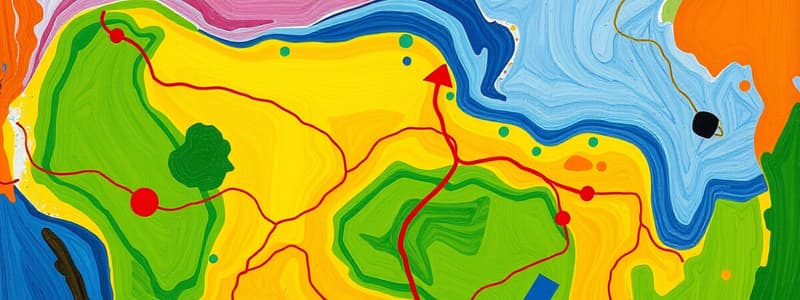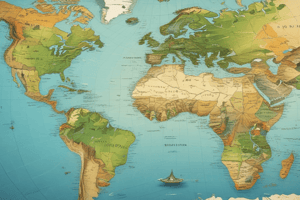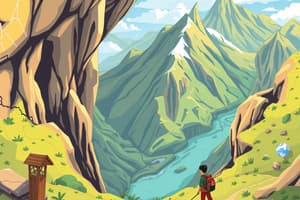Podcast
Questions and Answers
What are the three branches of government mentioned?
What are the three branches of government mentioned?
Executive, Legislative, Judicial
Who can declare Martial Law?
Who can declare Martial Law?
- The Cabinet Secretaries
- The Vice-President
- The President (correct)
- The Senate
A senator must be at least ______ years old.
A senator must be at least ______ years old.
35
A house representative must be at least ______ years old.
A house representative must be at least ______ years old.
How long can a senator serve?
How long can a senator serve?
How long can a representative serve?
How long can a representative serve?
A Filipino judge must be at least 40 years old to serve.
A Filipino judge must be at least 40 years old to serve.
Who are examples of Senate members mentioned?
Who are examples of Senate members mentioned?
Who is the Chief Justice mentioned?
Who is the Chief Justice mentioned?
The Vice-President has the authority to make laws.
The Vice-President has the authority to make laws.
What divides the eastern hemisphere from the western hemisphere?
What divides the eastern hemisphere from the western hemisphere?
What is the highest mountain in the Philippines?
What is the highest mountain in the Philippines?
Match the following regions with their descriptions:
Match the following regions with their descriptions:
Which region does Camarines Norte belong to?
Which region does Camarines Norte belong to?
Taal Volcano is the largest volcano in the Philippines.
Taal Volcano is the largest volcano in the Philippines.
What is the capital of the Philippines?
What is the capital of the Philippines?
Which of these is known as the 'Father of Philippine Constitution'?
Which of these is known as the 'Father of Philippine Constitution'?
What are the two seasons in the Philippines?
What are the two seasons in the Philippines?
The world's smallest freshwater fish is the ______.
The world's smallest freshwater fish is the ______.
What is the latitude of the Equator?
What is the latitude of the Equator?
Flashcards are hidden until you start studying
Study Notes
Maps and Geography
- A map is a representation of a place, providing spatial information about locations and distances.
- Latitude and longitude are essential for determining geographic coordinates; latitude lines run east-west, and longitude lines run north-south.
- The Equator is the major reference line at 0° latitude, dividing the Earth into northern and southern hemispheres.
- The Prime Meridian, located at 0° longitude, divides the eastern and western hemispheres.
- A grid is formed by the intersection of latitude and longitude lines, creating reference points for locations.
Philippine Geography
- The Philippines comprises 17 regions and various natural resources showcasing its rich biodiversity and cultural heritage.
- Two main seasons exist: the Wet season, influenced by the Habagat (southwest monsoon), and the Dry season, influenced by the Amihan (northeast monsoon).
- Significant landmarks include Mount Apo (highest mountain), Taal Volcano (active volcano), and Boracay (popular tourist destination).
Flora and Fauna
- Indigenous plants and animals are vital to the Philippines' ecosystem; examples include the Tarsier (small primate) and Durian (fruit).
- The Dwarf Goby, the world's smallest freshwater fish, is native to Palawan.
Historical Events and Figures
- Notable figures in Philippine history include:
- Dr. José Rizal, national hero and author of "Noli Me Tangere" and "El Filibusterismo."
- Emilio Jacinto, known as "Brains of the Katipunan," wrote the "Kartilya ng Katipunan."
- Juan Luna, renowned painter of "Spoliarium."
- Lapu-lapu, first Filipino hero to resist Spanish colonization.
Government Structure
- The government of the Philippines operates under three branches:
- Executive (headed by the President),
- Legislative (composed of Congress, which includes the Senate and House of Representatives),
- Judiciary (includes the Supreme Court and local courts).
- Significant laws include the Rizal Law, promoting the study of Dr. Rizal's works and contributions to Philippine history.
Civic Responsibilities and Values
- Citizens engage in government through voting and can serve in public office, reflecting their dedication to the country's democratic processes.
- Ordinary people can also become heroes through their service and love for their country, embodying the spirit of nationalism.
Studying That Suits You
Use AI to generate personalized quizzes and flashcards to suit your learning preferences.




